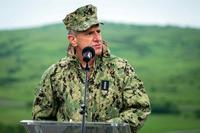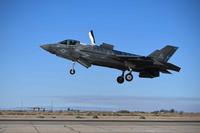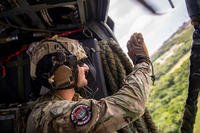Air Force, Marine Corps and Navy V-22 Ospreys were all given the green light to fly again in early March and have been slowly taking to the skies following a tragic crash that killed eight airmen late last year in Japan.
But months after the grounding was lifted, there are still restrictions in place that significantly limit the aircraft's ability to operate, Military.com has learned.
The services are barred from flying the controversial tiltrotor aircraft more than 30 minutes away from a suitable airfield to divert to in case anything goes wrong. That has caused some of the services, such as the Navy, to continue relying on other aircraft to accomplish tasks that the Osprey would have taken on.
Read Next: Military Must Focus on Efforts to Keep Its Child Care Employees to Shorten Waitlists, Watchdog Says
Cmdr. Beth Teach, a spokesperson for Naval Air Forces, confirmed to Military.com on Thursday that the restriction was handed down by the V-22 Joint Program Office, part of Naval Air Systems Command, and is a requirement that all the services are following.
It was not immediately clear what would constitute a suitable landing zone for the tiltrotor aircraft which, by design, is meant to land quickly like a helicopter in austere conditions.
The Joint Program Office declined to comment to Military.com regarding the restriction.
A spokesperson for the Marine Corps could not provide details on the restriction, but said efforts are underway to return the aircraft to full operations.
"Operational security associated with our forward-deployed Marines and sailors limits our ability to provide details regarding any potential platform restrictions," Capt. Pedro Caballero, a spokesperson for the Marine Corps, told Military.com when asked whether the restrictions applied to its roughly 350 Ospreys, the vast majority of the military's fleet.
"The Marine Corps, after a thorough review of all available engineering data and with revisions to the flight manual in place, is now enacting a deliberate plan to return all 17 MV-22 squadrons to full capability," Caballero said. "The Marine Corps' three-phased approach begins with a focus on regaining basic flight currency, rebuilding units' instructor cadres, and achieving proficiency in core and basic skill training for pilots and aircrew."
Lt. Col. Rebecca Heyse, a spokesperson for Air Force Special Operations Command, told Military.com that the service is following the Joint Program Office's guidance for their return to flight plans but didn't provide additional details about current flight restrictions.
That restriction was publicly identified in a House draft text of the national defense authorization bill released this week. The bill details limitations and woes with the Navy's variant, the CMV-22, and how it's forcing the sea service to continue to rely more heavily on its aging C-2A Greyhound fleet, lawmakers wrote.
"The committee understands that current CMV-22 operations are limited to flights and missions that stay within 30 minutes of a suitable divert airfield," according to the House Armed Services Committee document. "This prohibits the use of the CMV-22 for carrier onboard support of deployed aircraft carriers once they have left their homeport."
The Navy used the Greyhound, which has been in service for 60 years and is slated to be retired by 2026, to fill the gaps when the Ospreys were grounded, but even though the Osprey is flying again, it appears the service is still relying on the planes.
That raised concerns for lawmakers who asked the Navy to provide House Armed Services with a report by Feb. 1, 2025, on how the service will adjust once the C-2A is no longer available.
"With no other option available, the committee supports this interim solution but recognizes it is not a viable long-term solution beyond 2026," the draft bill said.
News about the Navy's restrictions and that it affected all variants of the Osprey was first reported by Aviation Week.
All of the services have been cautiously returning to the skies following a Nov. 29 Air Force special operations Osprey crash off the coast of Japan that killed all eight service members on board -- the deadliest CV-22 crash in the service's history -- and led to a monthslong, military-wide grounding of the aircraft.
Military.com reported earlier this month that the Air Force had begun conducting flight checks for its Osprey variant, the CV-22. The Marine Corps and the Navy began flying some of their aircraft in March, the same month the Joint Program Office gave the OK to resume operations.
The Osprey Joint Program Office provided few details on what mechanical failure led to the deadly crash and how it planned to fix it.
"We have high confidence that we understand what component failed, and how it failed," Marine Corps Col. Brian Taylor, the manager of the V-22 program, told reporters in March. "I think what we are still working on is the 'why.'"
Meanwhile, the Osprey is looking at a makeover that officials hope will keep the aircraft flying until at least 2055 -- and beyond.
The Joint Program Office, which oversees the V-22's development and operations, is looking to replace aging components in the aircraft's cockpit, as well as test solutions for a mechanical issue that has led to more than a dozen mishaps in its operational lifespan.
"There's a ton of life left in this platform and there's a ton of mission left in this platform," Taylor said last month at the Modern Day Marine Expo in Washington, D.C.
The mechanical issue the program office hopes to address involves a notorious clutch problem, called a "hard clutch engagement," which contributed to a crash in 2022 that killed five Marines. It is also known to have been involved in at least 15 other V-22 incidents since 2010.
Taylor mentioned that the program office oversaw the disassembly of clutches within the aircraft, including V-22s with 2,000 hours of flight and those with less than a hundred, which "helped us better understand this environment inside of this clutch assembly," he said.
He added that a new prototype for one of the likely culprits causing this issue -- the input quill assembly -- will be tested within the next month. That prototype includes 15 design changes, he said.
"When you purchase aircraft over about a 30-year span, you end up with some configuration challenges," Taylor said. "And that's what we're still kind of working through."
While operations are limited, Taylor said that Ospreys are abundant in the air -- and have been for more than two months.
"I haven't done this math problem, but it's pretty safe to say that 24 hours a day, there's a V-22 flying somewhere on the planet ... doing our nation's business," he said.
Related: Air Force Starts to Fly Some Ospreys Again Following Crash that Killed 8 Airmen in Japan













